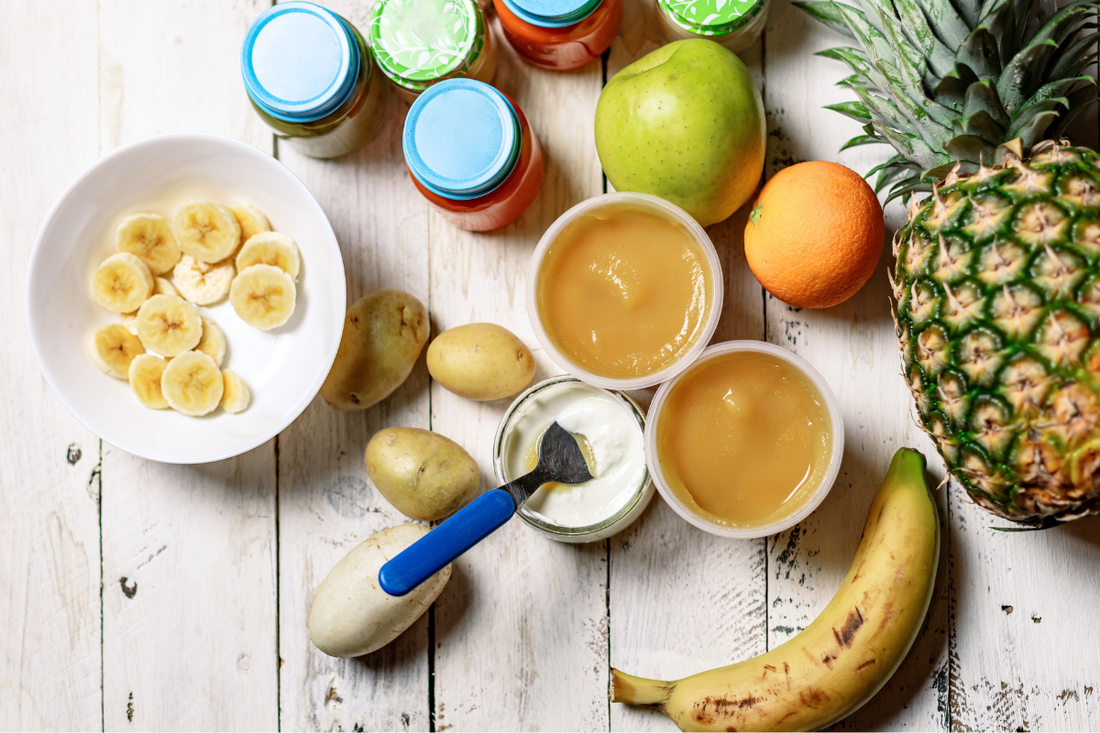
Baby Food Stages Explained: What Are Stage 1, Stage 2, and Stage 3?
By Leanne GrantWhat is Stage 1, Stage 2 and Stage 3 in Baby Food?
When you’re starting solids with your baby, one of the first things you’ll notice in the baby food aisle is that pouches, jars, and purees are often labeled by “Stage 1,” “Stage 2,” or “Stage 3.” But what do these stages actually mean? And who decides what’s in them?
As parents ourselves at Loco Bebé, we know how overwhelming starting solids can be. In this guide, we’re breaking down what each stage typically refers to, how they differ, and what types of baby food are most common in each category — all so you can make informed choices that work for your little one’s unique journey.
What Are Baby Food Stages?
The concept of stages was introduced by baby food companies (like Gerber and Beech-Nut) as a general guideline to help parents understand which textures and ingredient combinations might be appropriate based on a baby’s age and developmental milestones.
While there’s no official medical regulation or government standard that defines the stages, most pediatricians and baby food brands generally agree on the following:
Stage 1 Baby Food (4 to 6 months)
Single Ingredient, Smooth Purees
Stage 1 is all about introducing solids for the first time. At this point, your baby is likely just starting to get used to the idea of eating anything other than breast milk or formula. It’s not about meals — it’s about practice, exposure, and sensory exploration.
Typical Characteristics:
-
Smooth, runny consistency
-
Single-ingredient purees
-
No added salt, sugar, or spices
-
Very small portions (sometimes only a spoonful or two!)
Common Stage 1 Foods:
-
Organic banana puree
-
Mashed avocado
-
Steamed and blended carrots or sweet potato
-
Iron-fortified infant cereal
-
Loco Bebé’s Hola Piña pouch (for a tropical first taste!)
Pro tip: Wait 2–3 days between introducing new foods to monitor for allergies.
Stage 2 Baby Food (6 to 8 months)
Thicker Textures and Simple Combos
Stage 2 is for babies who have adjusted well to Stage 1 and are ready for a bit more texture and variety. At this stage, babies are developing stronger swallowing skills and may be eating more each time they sit down for a meal.
Typical Characteristics:
-
Thicker purees (but still soft and mashable)
-
Multi-ingredient blends
-
Introduction to mild herbs, spices, or healthy fats (like olive oil or coconut oil)
-
Introduction of protein (lentils, chicken, turkey, beans)
Common Stage 2 Foods:
-
Blended mango + oats
-
Mashed lentils and carrots
-
Pear + spinach + quinoa puree
-
Loco Bebé’s Totally Tropical or Sweet Potato Paradise (complex flavors with nutrient-rich veggies and fruit)
Stage 2 is a great time to start introducing more diverse flavors to help develop your baby’s palate and reduce picky eating later on.
Stage 3 Baby Food (8 to 12+ months)
Chunky Textures, Finger Foods, and Mini Meals
Stage 3 foods are designed for babies who are learning to chew, self-feed, and explore textures. At this point, your baby may have a few teeth and be ready for more “grown-up” meals in baby-sized portions.
Typical Characteristics:
-
Thicker, chunkier textures
-
Soft-cooked vegetables and finger foods
-
Small pieces of soft fruit, shredded meat, or pasta
-
Foods that encourage chewing and pincer grasp development
Common Stage 3 Foods:
-
Mashed beans and rice
-
Scrambled egg pieces
-
Soft fruit cubes like banana or ripe peach
-
Soft pasta with veggies
-
Loco Bebé pouches paired with whole finger foods as part of a mini meal
Stage 3 is also when some babies transition from purees to more of a baby-led weaning style — eating soft solids they can hold and feed themselves.
Are These Stages Really Important?
The short answer: They’re helpful but not mandatory.
These stages aren’t based on strict science — they’re based on developmental milestones and convenience. They help give structure to a process that can feel messy and unpredictable.
Some babies fly through the stages in a few weeks. Others take their time, regress, or skip stages altogether. And that’s totally okay!
The most important thing is to watch your baby, not the label. Are they sitting up well? Showing interest in food? Able to chew and swallow without difficulty? That’s your best guide.
Final Thoughts
At Loco Bebé, we believe that baby food should be simple, real, and full of flavor — no matter what stage you’re in. Whether you're offering your baby their very first taste of mango or packing a pouch for an on-the-go toddler snack, we're here to support your feeding journey with nutritious, organic options straight from our farm to your family.
Remember: Every baby is different. Follow your instincts, offer a variety of textures and flavors, and talk to your pediatrician if you have questions.
Disclaimer: This blog reflects general industry practices and personal experience. Every child is different. Please consult your pediatrician or family doctor before introducing new foods or making decisions about your child’s diet.